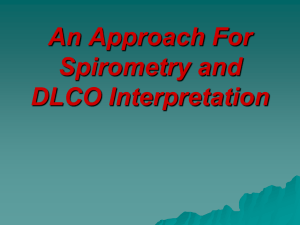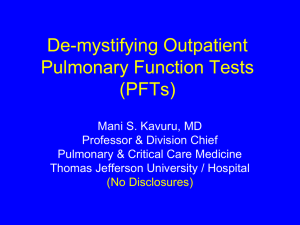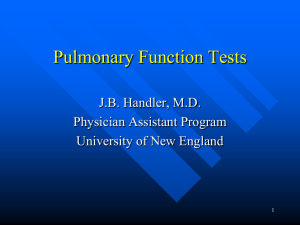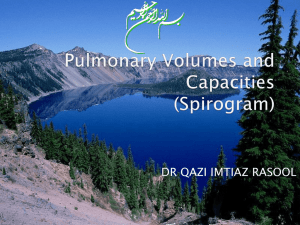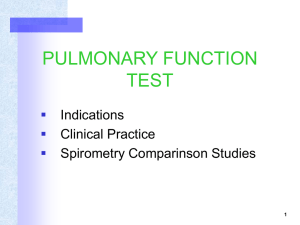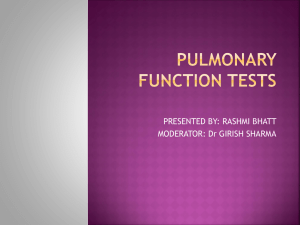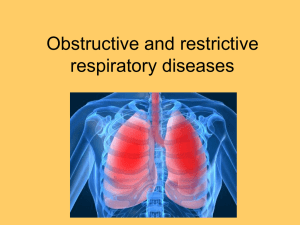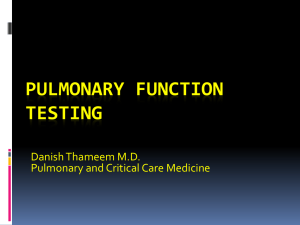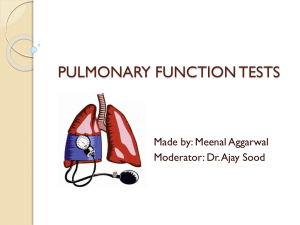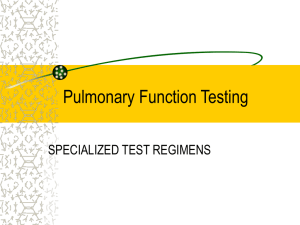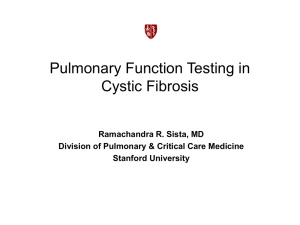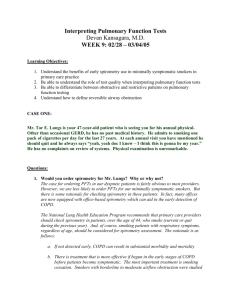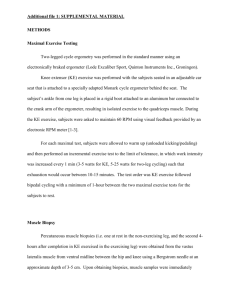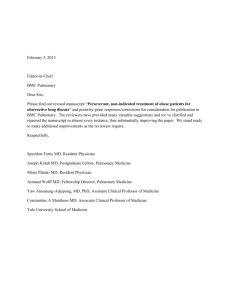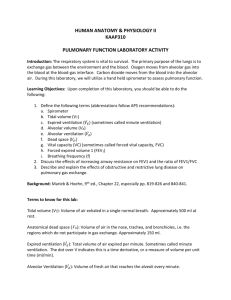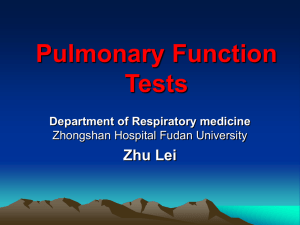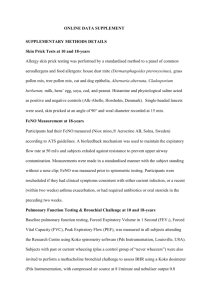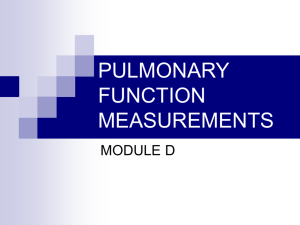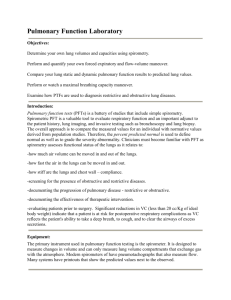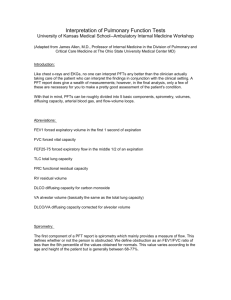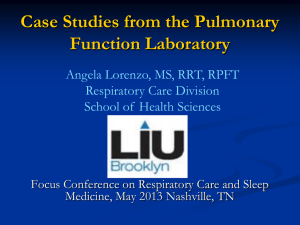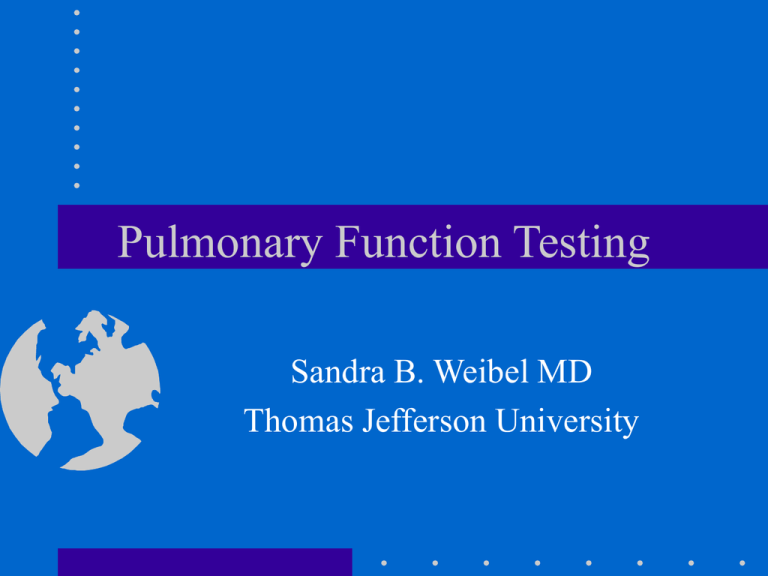
Pulmonary Function Testing
Sandra B. Weibel MD
Thomas Jefferson University
Indications
• Differential diagnosis of dyspnea
• Provides objective assessment of symptoms
versus severity
• Determine fitness for surgery
• To guide therapy
• To follow the course of a disease
Physiologic classification of
disease
• Obstructive Impairment- Airway limitation
due to the resistive properties of the
respiratory system
• Restrictive Impairment- Loss of volume
capacity of the lung due to loss of air space
units or inability to expand the respiratory
system
Obstructive Processes
•
•
•
•
L ocal obstruction
A sthma
C hronic bronchitis (COPD)
E mphysema
Restrictive Processes
•
•
•
•
•
P leural disease
A lveolar filling processes
I nterstial lung disease
N euromuscular diseases
T horacic cage abnormailites
Spirometry
• Most widely performed study and is
important in initial screening of patients
• Easily and quickly performed in many
settings
Types of spirometers
• Types include flow (pneumotach) or
volume (water seal, rolling and diaphragm)
• Water seal device previoisly most
commonly used in pulmonary function labs
of the volume
– Collect exhaled gas and act as a reservoir for
inhaled gas
– Composed of a mouthpiece, bell system and a
pen on a rotating drum
Volume Displacement Spirometer
Flow Spirometry
Calibration of spirometer
• Warmed up and temperature controlled
Barometric pressure and temperature
recorded
• Volume calibration with 3L syringe (within
3%)
• Flow spirometer tested at 3 flow rates
between 2 and 12L
Quality Control
Prior to testing
Performing the maneuver
• It is a forced expiratory maneuver and the
patient must be sitting upright in a chair
with lips around a mouthpiece
• After a maximal inspiration, a forced and
rapid expiration is made
• Quality of the maneuver needs to be
assessed noting that the patient started at
zero, had a maximal initial efffort and lasted
6 seconds.
Measurements
•
•
•
•
FVC
FEV1
FEV1/FVC
Also FEF25-75 and TET
FVC Measurement
FEV1 Measurement
Flow volume
Interpretation
• First need to assess the quality of the
maneuvers
• Choice of reference values
• Use of LLN
• Compare to previous tests
• Race adjustments
Interpretation
• Restrictive Lung
– FVC AND FEV1
decreased
– FEV1/FVC normal
– FEV1 main
distinguishing feature
• Obstruction
– FEV1 decreased
– FVC Normal
– FEV1/FVC are low
Pitfalls in Interpretation
• Predicted need to fit your population
• Non Caucasians have lower lung volumes
and this may need to be addressed
• Prior to interpretation the test needs to be
assessed to see if it meets standards
• Machines need to be calibrated daily to
ensure accuracy
Effort
Poor effort
Interpretation
• The patient’s data is compared to predicted
• Predicted values are obtained after studying
populations of normal nonsmokers and then
regression equations developed
• Regressions are based on sex, height, and
age.
Predicted Values
Decline in PFTS
References
• Many different ones used in past Knudson
Crapo etc
• Current recommendation is NHANES III
• This studied over 7000 individuals
• Included Caucasians, blacks and Mexican
Americans
Interpretaion
• Normal is > 80% of predicted
– Mild impairment 65-79%
– Moderate 50 -64%
– Severe < 50%
Interpretations
Flow Volume Loops
• Inspiratory loops can also be obtained to
evaluate for the presence of large airway
obstruction
• Theory changes in pressure outside and
inside the thoracic cage will cause changes
in airway diameter
• These airway changes can cause a
limitation to airflow if large enough
Extrathoracic Obstruction
Intrathoracic Obstruction
Fixed Obstruction
Large Airway Obstruction
Bronchodilator Response
Bronchodilator testing
•
•
•
•
•
No short acting agents for 4 hrs
No long acting beta agonists for 12 hrs
No theo for 12 hrs
No smoking for 1 hr
Beta agonist given recommended 4 puffs
and wait 10-15 minutes later
Performance of the Maneuver
Peak Flow Measurements
• Convenient portable device for measuring
peak expiratory flow in l/min
• May be less reliable than spirometry but
easy to use and inexpensive
• Useful to follow the course of asthma and to
possibly look and work exposure
• Technique
Lung Volumes
• May be measured by multiple methods
• Is important to understand what volumes
the lung is composed of
• The total volume of the lung is TLC
• The subdivisions include ERV, IRV, TV,and
RV
• Capacities are composed of 2 or more
volumes.
Helium Dilution Technique
• Uses an inert gas, helium and by a closed
circuit technique, allow it to come to
equilibrium and FRC is measured
• May underestimate lung volumes in bullous
lung disease
Nitrogen Washout
• Determine FRC by multiple breath open
circuit nitrogen washout
• Involves having nitrogen in patients lung
being washed out by inhaling 100% O2 for
several minutes.
• Widely used, easy to perform but may
underestimate bullous lung disease
Nitrogen Washout
• Performed by having the patient breath
comfortably for several minutes and then
turn in to 100% O2 at FRC.
• Monitor N2 concentrations and test ends
when falls below 1%
• Easy to see leaks
Nitrogen Washout
• Concept is C1V1= C2V2
– C1 = Nitrogen concentration at the start of the
test
– V1 = FRC volume
– C2 =N2 concentration in exhaled volume
– V2 = Total exhaled volume during O2
breathing period
– Nitrogen is measured by photoelectric principle
Body Plethsymography
• Is a sealed box with a fixed volume
• Uses Boyle’s Law that changes in pressure
are brought about by changes in volume for
the person seated in the box
• P1V1= P2V2
Body Plethysmograph
Lung volume measurements
• FRC is directly measured as well as SVC
• Other volumes and capacities can be
calculated
• Lung volume measurements are important
to confirm RLD
• TLC and RV the usual volumes assessed
Interpretation
• RLD
– TLC is reduced in all
– Predicted values and
interpret same as FVC
and FEV1
• OLD
– TLC can be increased
and is then called
hyperinflation (120%)
– RV can be increased in
asthma and COPD
indicating air trapping
Diffusing Capacity
• Provides information about the transfer of
gas between the alveoli and the pulmonary
capillary bed
• It is the only noninvasive test of gas
exchange
• Performed by a single breath technique and
uses CO as the inert gas
Diffusing Capacity
• Diffusion of a gas is dependent of the area,
the concentrations, the thickness of the
membrane and the diffusing properties of
the gas
• Diffusion is the rate at which a gas is
transferred across the alveolar capillary
membrane, the plasma, the RBC and
ultimately combined with Hgb
Diffusing Capacity
• CO is typically used because it is freely
diffusable
• It usually is not present in significant
amounts in the blood except in some heavy
smokers
• Helium or methane is also used to measure
volume
• A single maximal inspiration is taken and
held for 10 sec
Diffusing Capacity
• Normal result is >80%
• Can be reduced in interstitial diseases such
as sarcoid or asbestosis
• Can be reduced also in emphysema or
pulmonary vascular diseases
• False low measurements in anemia or lung
resection and elevated in alveolar hemm
Summary
• Spirometry- Most commonly performed and
useful screening test.
• Lung volumes- Can be measured several
different ways. Are used to evaluate for
restrictive disease and will also show air
trapping
• Diffusing Capacity - Transfer of gas across
the alveolar membrane
Selecting Tests
•
•
•
•
Who should get what test
Who cannot get certain tests
Which method of lung volume testing
Inpatients
Case 1
• A 25 year old female comes to your office
complaining of chest tightness and
shortness of breath with running.
• Exam is normal
• What tests would you order?
Spirometry
• Pre
–
–
–
–
–
FVC 2.64 90%
FEV1 1.83 79%
FEV1/FVC 69
TET 5.0
FEFmax 4.85 L/S
• Post
–
–
–
–
–
3.12 106%
2.21 95% (18%)
FEV1/FVC 71
TET 5.5
FEFmax 5.02 L/S
Case 2
• A 58 year old male presents to office
complaining of dyspnea on exertion over
the last 6 months. He has a dry cough but no
other complaints. He has smoked 1ppd for
35 years and works in construction.
PFTS
•
•
•
•
•
FVC 1.43 48%
FEV1 1.30 57%
FEV1/FVC 91
TLC 3.05 63%
RV1.53 68%
•
•
•
•
•
Dsb 5.78 24%
Dsb(adj) 7.8 33%
VA 2.3 42%
D/VA 2.51 57%
Hsb 11.4

